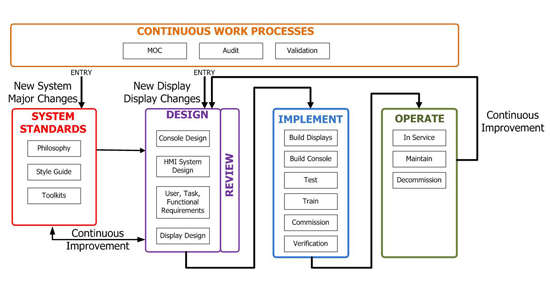This excerpt from InTech magazine is authored by Greg Lehmann of URS Corporation and Maurice Wilkins of Yokogawa Corporation.
Update: The ISA100 HMI standard is expected to published in September 2015. For more information about the ISA101 standards development, contact Charley Robinson of ISA Standards, crobinson@isa.org, or 1-919-990-9213.
The ISA101 HMI (human-machine interfaces) committee was formed to establish standards, recommended practices, and technical reports relating to HMIs in manufacturing and processing applications. The forthcoming standard and accompanying technical reports are intended to help users understand the basic concepts as a way to more readily accept the style of human-machine interface that the standard recommends. It is aimed at those responsible for designing, implementing, using, or managing HMI applications.
The standard defines the terminology and models to develop an HMI and the work processes recommended to effectively maintain it throughout its life cycle.
Use of the standard should:
- Provide guidance to design, build, operate, and maintain effective HMIs that result in safer, more effective, and more efficient control of a process, under all operating conditions.
- Improve the user’s abilities to detect, diagnose, and properly respond to abnormal situations.
If the standard, recommended practices, and methodology are followed, the result should enable the users to be more effective in yielding improved safety, quality, production, and reliability.
Wide scope, wide input
The scope of the committee was to include menu hierarchies, screen navigation conventions, graphics and color conventions, dynamic elements, alarming conventions, security methods and electronic signature attributes, interfaces with background programming and historical databases, pop-up conventions, help screens, and methods used to work with alarms, program object interfaces, and configuration interfaces to databases, servers, and networks.
The HMI is the critical link between operators and automation systems. The human operator depends on the output of the HMI to provide feedback on the physical process. It is the tool operators use to adjust operating parameters. An HMI that is easy to understand and gives clear options to end users will produce fewer errors, increase operator productivity, and reduce stress. Improved HMI design can prevent significant losses to a business in terms of time and materials wasted.
Committee members include end users, integrators, and suppliers. At present, the committee is comprised of 230 members from many different industries and countries. Our members bring lessons learned from many years of designing, integrating, and using various HMI applications.
Over a series of initial face-to-face and virtual ISA101 meetings, several topics were identified, and appropriate clauses for the first draft were formed. Strong clause editors volunteered, and the draft began to take shape.
Presently, the draft standard is organized as follows:
- Clause 0: General
- Clause 1: Scope
- Clause 2: Normative References
- Clause 3: Definition of Terms and Acronyms
- Clause 4: HMI System Management
- Clause 5: Human Factors/Ergonomics
- Clause 6: Display Types
- Clause 7: User Interaction
- Clause 8: Performance
- Clause 9: Documentation and Training
As with all standards, establishing a common set of terminology and definitions was vital. You cannot have a standard until you all speak the same language. The ISA101 committee came up with an easy-to-understand diagram showing what was meant by terms, such as graphic, symbol, and so on. Having done that, progress lagged until a pivotal decision was made at a face-to-face meeting in Indianapolis, Ind.
Click here to read the complete article on the ISA101 HMI stantard at InTech magazine.
About the Authors Greg Lehmann is ISA101 co-chair and technical manager of the process automation department of URS Corporation, Oil & Gas Division, in Lakewood, Colo.
Greg Lehmann is ISA101 co-chair and technical manager of the process automation department of URS Corporation, Oil & Gas Division, in Lakewood, Colo.
Connect with Greg:![]()
![]()
![]()
 Maurice Wilkins is ISA101 co-chair, an ISA Fellow, and vice president of the Yokogawa Global Strategic Marketing Center in Carrollton, Tex.
Maurice Wilkins is ISA101 co-chair, an ISA Fellow, and vice president of the Yokogawa Global Strategic Marketing Center in Carrollton, Tex.
Connect with Maurice:![]()
![]()




